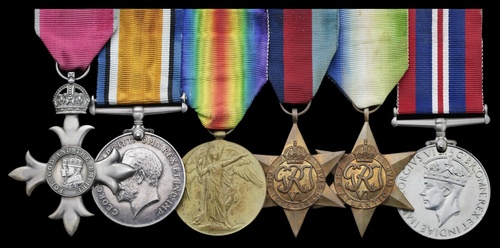
Auction: 22003 - Orders, Decorations and Medals
Lot: 430
The Great War and Second World War M.B.E. group of six awarded to Chief Engineer J. W. Pugh, Merchant Navy, late Mercantile Marine Reserve who saw Balloon service aboard H.M.S. Manica during the Great War and was later Chief Engineer of the Themston during the Second War
The Most Excellent Order of the British Empire, 2nd Type (M.B.E.), Civil Division breast Badge, silver-gilt; British War and Victory Medals (J. W. Pugh. Ord. S.S. Manica. M.M.R.); 1939-45 Star; Atlantic Star; Defence Medal 1939-45, contact wear, very fine (6)
M.B.E. London Gazette 9 January 1946.
John Wynn Pugh was born at Pontypridd, Wales in 1889. Joining with the Merchant Navy Pugh was serving as an Ordinary Seaman during the Great War and was recruited into the Mercantile Marine Reserve for service with H.M.S. Manica.
With the development of Rigid Kite Balloons as a method of spotting for enemy movements it was decided to hire a merchantman for conversion to a balloon ship. The first of these acquired by the Admiralty was the S.S. Manica - later the H.M.S. Manica - which was hired on 11 March 1915 with the original crew being kept on as Mercantile Marine Reserve and No. 1 Kite Balloon Section embarking on 22 March. Refitted for balloon use she was also armed with a three-pound gun and two maxim machine guns.
Her trial by fire was at the Dardanelles where the balloon guided the immense firepower of the British Fleet to targets on land and at sea. However Pugh's entitlement suggests he joined the ship later, after she was deployed to East Africa at the request of General Smith-Dorrien.
Here the Balloon was again put to good use, being sent up for the first time on 21 April 1916. In early June she was spotting for the bombardment of Tanga and in late June performed the same role with Challenger while attacking enemy shipping. By this time a seaplane had also been fitting to Manica and as well as reconnaissance they could also perform bombing missions.
By September Manica was also fulfilling the role of a troopship, taking a strike force to Mikindani on 13 September. She served in this capacity until August 1917 when she returned to work as a tanker with the new name of Huntball.
Pugh returned to his role as a merchant sailor around the same time and was promoted to the rank of Chief Engineer. Despite his age he was still sailing at the outbreak of the Second World War and continued to do so throughout aboard the Themiston. Awarded an M.B.E. after the war for his services throughout, Pugh did not live long - but true to form he died at sea, of heart failure, on 20 February 1946; sold together with copied research including service records, London Gazette entries and crew lists as well as extracts from Kite Balloons at Sea, Royal Naval Air Service - Operations in German East Africa and Royal Navy Shipboard Aircraft Developments 1912-1931.
Subject to 20% VAT on Buyer’s Premium. For more information please view Terms and Conditions for Buyers.
Sold for
£260
Starting price
£200




